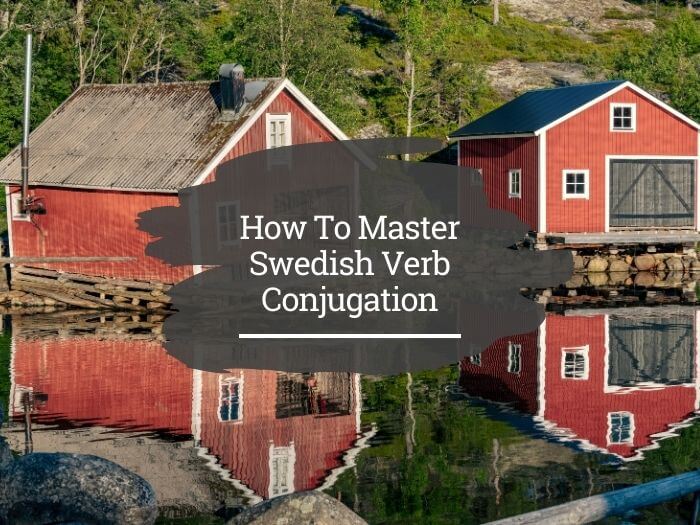One of the most basic things you have to know when learning Swedish is verb conjugation.
In this post, you'll discover what verb conjugation is and how you can master Swedish verb conjugation.
You'll also get a few tips on how to continue improving your Swedish even after you’ve mastered the basics of verb conjugation.
Pro Tip
By the way, if you want to learn Swedish fast (including Swedish verb conjugation) and have fun, my top recommendation is Swedish Uncovered which teaches you through StoryLearning®.
With Swedish Uncovered you’ll use my unique StoryLearning® method to learn Swedish through story…not rules. It’s as fun as it is effective. If you’re ready to get started, click here for a 7-day FREE trial.
Table of Contents
What Exactly Is Swedish Verb Conjugation?

Now, before diving into this post, let's speak a little bit about conjugation.
Conjugation is an essential part of most languages and often mastering conjugation is also the key to mastering the language.
This is because verbs, words like “walk” or “read”, are used in almost every single sentence and are often conjugated depending on the rest of the words in that sentence. Mastering the verbs makes it easier to master the rest of the sentence.
Conjugation means that the verbs change depending on things like gender, person, number, case and much more. For some languages, like Spanish, that means the same verb is different for different pronouns and more.
Swedish verbs, in particular, are relatively easy to conjugate because they don't change, or inflect, depending on person or number (the verb is the same for all pronouns). Instead they only change depending on grammar tenses and moods.
This makes it so much easier to master Swedish verb conjugation!
There are seven verb forms in total, five are for active forms and two are for the participle. (The participle is both an adjective and a verb, but I will touch on that a bit later) For almost every one of the active forms, there's also a corresponding passive form.
Passive voice is used much more commonly in Swedish than in English, which might feel foreign to you if you are a native English speaker. But hopefully, they will feel easier soon! Let’s move on to them!
The Different Verb Forms In Swedish

As already mentioned, seven verb forms exist in Swedish, with some used more than others. The active form has infinitive, present, preterite/past, supine and imperative, while the passive form has all of them except imperative.
If these grammar terms seem a bit confusing, don't worry. You'll see examples in the table below and they'll make sense very quickly.
The participle is when a word has been formed from a verb and then used as an adjective. It’s a tricky category and some view it as a verb, while others view it as an adjective.
The participle is often included when conjugating verbs on Swedish conjugating sites, so I'm including it in this article so you know what it is.
Let’s look at the table below. I have used tala (speak) as the verb and have also added the English translation to each entry so you know what it means. This is a good table to get a hang of because this is it when it comes to verb forms in Swedish.
| active form | passive form | |||
| infinitive | att tala (to speak) | att talas (to be spoken) | ||
| present | talar (speak/speaks) | talas (is spoken) | ||
| preterite/past | talade (spoke) | talades (was spoken) | ||
| supine | har/hade talat (have/had spoken) | har/hade talats (has been spoken) | ||
| imperative | tala! (speak!) | |||
| participle | ||||
| present participle | talande | (speaking) | ||
| past participle | en talad ett talat den/det/de talade | (spoken) |
The Passive
Verbs, in both English and Swedish, can be active or passive. For instance, “Many swedes speak English and Swedish” is an active sentence. You know who is doing the speaking!
But, in the passive form of this sentence, “English and Swedish are spoken” you no longer know who is doing the speaking. The emphasis is on the action rather than who does it.
In Swedish, the passive form always ends with an s and it is added to the active form of the same tense. If the active tense ends with an r however, that letter should be removed before adding the s.
This means that if you ever bump into a Swedish verb in the wild that ends with an s – it’s most likely a passive form of the verb. Remember that and the passive forms will probably be a breeze.
The passive form is also more widely used in Swedish than in English, with common phrases like Vi ses! (See you!). Also, note that the passive form is occasionally used with personal pronouns in Swedish.
Swedish Future
Another important thing to note is that there isn't a future tense in Swedish. And this makes your life easier!
Instead, the rest of the forms are used in different constructions and combined with the verbs ska (shall/will/going to) or kommer att (going/will) to indicate something that is going to happen.
For example, Jag ska baka en kaka (I’m going to bake a cake), you can see ska paired with the infinitive baka to indicate something that is going to happen.
Swedish Verb Conjugation: The Different Verb Groups In Swedish

Let’s move on to the verb groups in Swedish. There are four of them and they are conjugated in different ways
Group 1: Verbs That End With The Letter a, And Keep The a When Conjugated
I often tell Swedish learners that this is by far the most important verb group to learn when starting out. Why?
More than half of the Swedish verbs are estimated to belong to this group. So if you learn how to conjugate verbs from this group, then you are good for more than half of all the verbs. And that’s quite an impressive number, isn't it?
Every single verb in this group ends with the letter a in its infinitive form. Easy, you might think. Well, not quite because all the verbs in group two end with the letter a as well, but I’ll get to that later.
For verb group one the infinitive form is kept as a verb stem and from there on you add suffixes onto this stem to create the other verb forms.
- +r is added to the present form
- +de to the past
- +t to the supine form
- +nde to the present participle.
The imperative form is just the verb stem/infinitive form and the passive forms just take an s at the end. The tricky form is the past participle which has three different suffixes depending on the article at the beginning of the word.
Take a look below:
| active form | passive form | ||
| infinitive | att prata (to talk) | att pratas (to be talked [about]) | |
| present | pratar (talk/talks) | pratas (is talked [about]) | |
| preterite/past | pratade (talked) | pratades (was talked [about]) | |
| supine | har/hade pratat (have/had talked) | har/hade pratats (has been talked [about]) | |
| imperative | prata! (talk!) | ||
| participle | |||
| present participle | pratande | (talking) | |
| past participle | en pratad ett pratat den/det/de pratade | (talked) |
You can refer to this table when conjugating all the verbs in verb group one because most behave in this way.
There are a few minor exceptions, mainly words that don’t use past participles (unless certain criteria are met), for example, titta (look).
But all of the active and passive forms of the tenses are the same throughout all the verbs. When conjugating participles I would recommend using external sources, like Swedish verb conjugation sites, to ensure that the conjugation is correct.
Group 2: Verbs That End With The Letter a, That's Removed When Conjugated

The next group is verb group two and as you already know, the verbs in that group also end with the letter a.
The difference between groups one and two however is that the a in this group is removed when forming the verb stem.
To make up for the lack of vowels at the end of the verb, +er is added instead of +r in the present form. For the rest of the forms, the suffixes are the same as for group one.
The thing to note though is that if +de is added to a verb stem that ends with a d, one of the ds falls away. And if d is combined with a voiceless consonant, like s, f, p, t, k or x, the d is transformed into a t.
Note that in this table one of the ds in the past tense has fallen away and in the supine form the d has been changed to a t.
| active form | passive form | ||
| infinitive | att använda (to use) | att användas (to be used) | |
| present | använder (use/uses) | används (is used) | |
| preterite/past | använde (used) | användes (was used) | |
| supine | har/hade använt (have/had used) | har/hade använts (has been used) | |
| imperative | använd! (use!) | ||
| participle | |||
| present participle | användande | (using) | |
| past participle | en använd ett använt den/det/de använda | (used) |
In this table the d has been changed to a t in the past tense.
| active form | passive form | |
| infinitive | att läsa (to read) | att läsas (to be read) |
| present | läser (read/reads) | läses (is read) |
| preterite/past | läste (read) | lästes (was read) |
| supine | har/hade läst (have/had read) | har/hade lästs (has been read) |
| imperative | läs! (read!) | |
| participle | ||
| present participle | läsande | (reading) |
| past participle | en läst ett läst den/det/de lästa | (read) |
One tip I have used a lot to check if the verb belongs to verb group one or two is to check the imperative. Imperatives in group one will end in the letter a, while the second group won’t. It’s a clever way to check which group the verb belongs to.
Group 3: Words That Are One Syllable Long And End With A Long Vowel

The next Swedish verb group is the third group and only verbs that are one syllable long and end with a long vowel (except a) are included.
The infinitive form, verb stem and imperative form are all the same and suffixes are added to them to create the rest of the forms.
The present form suffix is a +r, the same as for the first group, but for the past tense and supine form you instead add +dde and +tt respectively.
+ende is added to the present participle and for the past participle +tt, +dd or +dda is added depending on the article before the word.
| active form | passive form | |
| infinitive | att tro (to believe) | att tros (to be believed) |
| present | tror (believe/believes) | tros (is believed) |
| preterite/past | trodde (believed) | troddes (was believed) |
| supine | har/hade trott (have/had believed) | har/hade trotts (has been believed) |
| imperative | tro! (believe!) | |
| participle | ||
| present participle | troende | (believing) |
| past participle | en trodd ett trott den/det/de trodda | (believed) |
Group 4: Irregular Swedish Verbs

The last group, the fourth group, is also the most difficult group out of all the Swedish verb groups. It’s because it lacks a standardised conjugation for all verbs. Instead, it’s made up of Swedish irregular verbs and strong verbs.
Every single one of them has to be learned which of course is very difficult when starting out. A few of the verbs are similar and are conjugated similarly to each other which will make it easier for you when learning these verbs.
And there's more good news. Some of the irregular verbs like att vara (to be) or att äta (to eat) are, as you can see, incredibly common.
So even if their conjugations don't fit the regular pattern, you'll pick them up easily enough, especially if you follow the rules of StoryLearning and read a lot in Swedish. As you read, you'll see these common irregular verbs over and over, so they'll soon become second nature.
I recommend starting with the first three verb groups, just to gain an understanding of how verbs work in Swedish and then moving on to irregularities and other difficult verbs later.
Just by learning the first three Swedish verb groups, you’ll probably cover most of the verbs in the Swedish language. Win!
FAQs About Swedish Verb Conjugation
Does Swedish have verb conjugations?
Yes, Swedish does have verb conjugation. The good news about Swedish verb conjugation is that Swedish verbs only change according to tense or mood, not person. That means that the verb forms are exactly the same not matter which pronoun you use – “I”, “you”, “he/she/it” etc.
What is the Swedish verb system?
Seven verb forms exist in Swedish, with some used more than others.
The active form has infinitive, present, preterite/past, supine and imperative, while the passive form has all of them except imperative.
Swedish also has four verb groups and verb conjugation varies according to each group. More than half of all Swedish verbs belong to group one. Group four contains irregular Swedish verbs and strong verbs.
Why do some Swedish verbs end in s?
Some Swedish verbs end in ‘s' because they're in the passive voice.
Verbs, in both English and Swedish, can be active or passive. For instance, “Many swedes speak English and Swedish” is an active sentence. You know who is doing the speaking!
But, in the passive form of this sentence, “English and Swedish are spoken” you no longer know who is doing the speaking. The emphasis is on the action rather than who does it.
In Swedish, the passive form always ends with an s and it is added to the active form of the same tense. If the active tense ends with an r however, that letter should be removed before adding the s.
This means that if you ever bump into a Swedish verb in the wild that ends with an s – it’s most likely a passive form of the verb. Remember that and the passive forms will probably be a breeze.
The passive form is also more widely used in Swedish than in English, with common phrases like Vi ses! (See you!). Also, note that the passive form is occasionally used with personal pronouns in Swedish.
What is the verb to know in Swedish?
The verb “to know” in Swedish is att veta.
Tips And Resources To Master Swedish Verb Conjugation

As with every other thing you learn about Swedish, just reading about the Swedish verb conjugation isn't enough. You need to put your newfound knowledge to practice!
You can do that by reading books in Swedish, writing texts, and more. It’s important to keep trying (and speaking!) even if you get it wrong sometimes, which you will. Don't let the grammar villain or the fear villain hold you back.
Something I found very valuable was finding a Swedish friend to practice with. That person can catch your mistakes, correct them and help you with your continued learning, all while you practise your speaking and Swedish pronunciation.
Another great thing to try is listening to Swedish podcasts, so you can hear native Swedes speak and maybe you'll be able to catch some Swedish verb conjugation.
Reading books, like short stories in Swedish, is also important because it’s easier to catch these verbs when seeing them in their written form.
Time to go immerse yourself in Swedish so you can master Swedish verb conjugation.

Olly Richards
Creator of the StoryLearning® Method
Olly Richards is a renowned polyglot and language learning expert with over 15 years of experience teaching millions through his innovative StoryLearning® method. He is the creator of StoryLearning, one of the world's largest language learning blogs with 500,000+ monthly readers.
Olly has authored 30+ language learning books and courses, including the bestselling "Short Stories" series published by Teach Yourself.
When not developing new teaching methods, Richards practices what he preaches—he speaks 8 languages fluently and continues learning new ones through his own methodology.










































